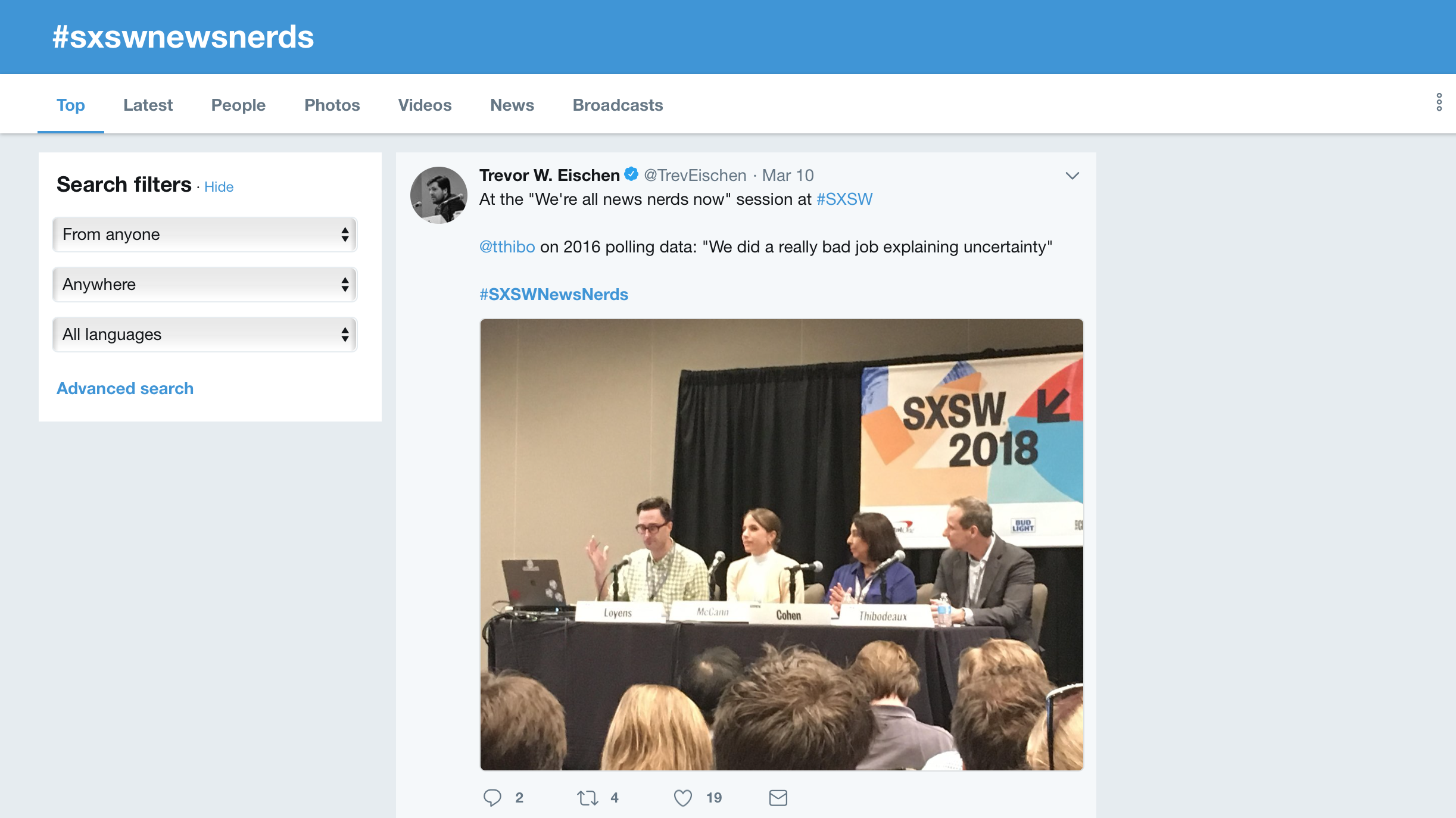SXSW: ‘Excel is okay’ and other tweet-size insights for data journalists and news nerds
Storybench has boots on the ground covering SXSW from multiple angles, including immersive storytelling, UX design and more. For those that didn’t make it to Austin this year, the next best option is to follow what’s happening on Twitter.
For data journalists looking to see what’s new and innovative in the realm of media, the hashtag #sxswnewsnerds compiled a bunch of great advice from a panel that featured Sarah Cohen, from Arizona State University, Jon Loyens, CPO at data.world, Troy Thibodeaux, from the Associated Press, and Allison McCann, data reporter for VICE News. You can also hear the full panel here.
Excel is okay
More than once I have heard from people I interviewed for Storybench that it is unrealistic to demand from journalists that they become coding whizzes in R, Python, and Javascript on top of being masterful interviewers and prolific writers.
“Excel is still great. Don’t feel like you need to code or be a strong programmer to work with data.” – @atmccann @vicenews #sxsw2018 #sxswnewsnerds
— len fishman (@lenfishman) March 10, 2018
'Everyone feels comfortable in the newsroom hearing that Excel is still okay. They don't need to be coders' #sxsw #sxswnewsnerds
— Nicolle Lamerichs (@nicolleness) March 10, 2018
But it seems that the bar is set at spreadsheets, once described as “the most important programming language in the world today” by Ben Zorn, a data scientist from Microsoft Research.
‘Surprising that we’re still seeing college students who aren’t a familiar with Excel. They should be learning this in 8th grade’ @sarahcnyt #sxswnewsnerds @atmccann @tthibo
— Sarah Frueh Bauer (@SJFrueh) March 10, 2018
“It’s no longer charming to be completely data illiterate” -@sarahcnyt #SXSWNEWSNERDS
— Tyler Durman (@durmantyler) March 10, 2018
Interview the data
The foundation of good journalism is multiple sources of information. There is no reason for data to be treated differently. Be skeptical of what data tells you and confirm it elsewhere — interviews with specialists and the people who collected the data, different datasets, etc.
“You should always be asking questions of your data in the same way that you would fact check your human sources.” – @atmccann from @vicenews #sxsw2018 #sxswnewsnerds
— len fishman (@lenfishman) March 10, 2018
Know the caveats and limitations
How was this data collected? Who collected it and for what purpose? What can it explain and what can’t it? Those are some of the questions a good reporter asks when working with data. The inferences that can’t be made from a dataset are just as important as the ones that can be.
.@sarahcnyt Data Journalism is a lot like being a scientist—you’re in the field where you collect your field notes, then in the lab where you analyze them. #sxswnewsnerds
— Schema Design (@schemadesign) March 10, 2018
A reporter must also effectively communicate those caveats and limitations to the audience. After the 2016 election, there has been an ongoing discussion on communicating uncertainty, probability, and predictive analysis in journalism. It remains an issue.
.@tthibo On data literacy: Data journalists have an obligation to explain things to an audience in a way they can understand. Accessibility is balanced with the novelty of the analysis/visualization. #sxswnewsnerds
— Schema Design (@schemadesign) March 10, 2018
"How do we communicate uncertainty?" is the question when looking at things like predictive polling in the 2016 election, said @tthibo in #SXSWNewsNerds panel.
— Taylor Tompkins (@Taylor_Paige13) March 10, 2018
Transparency
The concept of open-source is central to the “news nerds” community. Organizations like BuzzFeed News and FiveThirtyEight often publish their code on GitHub, while others like The New York Times have developed and released open-source tools, such as ai2html, that other newsrooms can take advantage of.
.@tthibo emphasizes the importance of reproducibility in data reporting: "Wherever we can, we should go as far as we can to be transparent." #SXSW #SXSW18 #SXSWNewsNerds
— Trev Eischen (@TrevEischen) March 10, 2018
Loving this panel on data journalism. Replication, transparency, understanding mechanisms, and communicating uncertainty are all important. Sounds a lot like academia! #SXSWNewsNerds
— Ashley Muddiman, PhD (@ashleymuddiman) March 10, 2018
Constraints
Data journalists tend to make everything about the data or that visualization. But sometimes those things are not the answer. A good editor goes a long way in helping reporters exercise constraint. Think about how one can best convey the given information. That’s a mantra we should follow for every single story.
Word to consider in the office all the time: "Not everything needs to be a graphic" if something can be explained better in a sentence says @VICE Allison McCann #sxswnewsnerds #sxsw
— Joy Sims (@JoySims) March 10, 2018
And when there’s no data?
Create it! It sounds simplistic – and collecting data can on its own be a beast – but it’s one way journalists can push governments and other institutions to start recording data.
@jonloyens @atmccann Allison: we had not seen data around police shootings until a few years ago; we do not have stats around civil rights and criminal justice as much as we should #sxswnewsnerds #sxswinteractive2018 pic.twitter.com/Zj3xQ2QMEA
— Chris Pfaff (@pfaffchris) March 10, 2018
Every story has a data angle – sometimes we just need to create those datasets @atmccann @tthibo #SXSW #sxswnewsnerds
— Grace Keith Rodriguez (@GKFintechPR) March 10, 2018
https://twitter.com/TonyFratto/status/972526041184030720
- SXSW: ‘Excel is okay’ and other tweet-size insights for data journalists and news nerds - March 17, 2018
- NICAR: Data stories from last year that you could be doing in your newsroom - March 13, 2018
- How to scrape Reddit with Python - March 12, 2018





